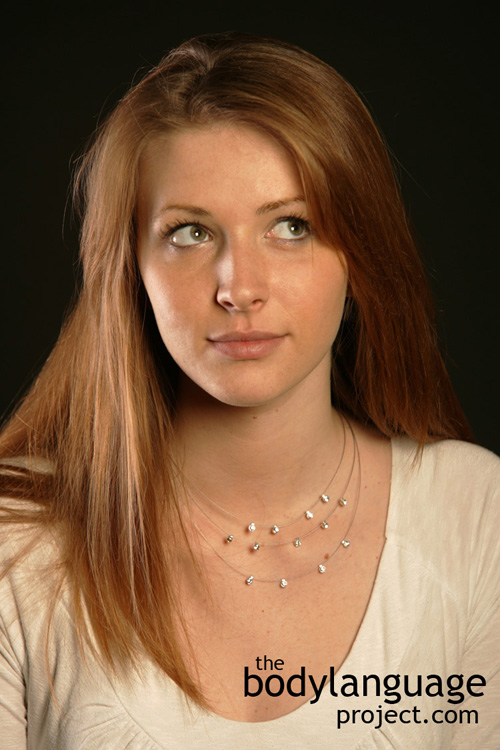Body Language of Looking To The Left
Synonym(s): Eye Access Cues
Description: Looking to the left.
In One Sentence: Looking to the left signals that a person (right handed) is accessing the creative side of their brain.
How To Use it: This is a cue that is used by reading it in other people. Simply watch how eyes move while another person is thinking in order to assess which sorts of memories are being accessed. For this to be effective, one must verify the cue’s accuracy by baselining it first. In most normal right handed people, looking left signals that a person is constructing a lie with the creative portion of their brain.
Researchers have noted that looking in one direction while thinking is not always reliable.
Context: General.
Verbal Translation: “I’m looking to the left to access the creative side of my brain so I can construct a lie or create a story. I am doing so either visually, auditorily, kinesthetically or with feelings.”
Variant: See Looking To The Right. The opposite will be the case for left handed people. Make sure you baseline this cue to determine is true accuracy on a case-by-case basis.
Cue In Action: When trying to come up with a story for why she was out so late, she looked up and to the left. From her eye access cue, her Dad knew she was creating a story rather than recalling one.
Meaning and/or Motivation: Looking left and up (as you look at person) is a nonverbal cue that signifies that a visual thought is being created (rather than remembered). This can be an indication that lying is taking place. However, in some context this can indicate creative storytelling as both areas of the brain function in this instance.
Looking to the left (level) indicates that a sound is being constructed rather than remembered. Looking down and left indicates the access of kinesthetic or feelings.
Cue Cluster: N/A
Body Language Category: Automatic gesture, Eye Language, Lying or deceptive body language, Microgestures, Pensive displays.
Resources:
Beck CE, Beck EA (1984) Test of the Eye-Movement Hypothesis of Neurolinguistic Programming: A rebuttal of conclusions. Percept Mot Skills. 58: 175–176.
Dilts, R.B., Grinder, J., Bandler, R., & DeLozier, J. 1979. Neuro-linguistic programming L Cupertino, CA: Meta Publications.
Ekman P (2001) Telling lies. Clues to deceit in the marketplace, politics, and marriage. New York: W. W. Norton & Company.
Elich M, Thompson RW, Miller L (1985) Mental imagery as revealed by eye movements and spoken predicates: A test of neurolinguistic programming. J Couns Psychol 32: 622–625
Gray R (1991) Tools for the trade: Neuro-linguistic programming and the art of
communication. Fed Probat 55: 11–16.
Galin, D. and Ornstein, R., 1974. Individual Differences in Cognitive Style – Reflective Eye Movements; Neuropsychologia, 12: 376-397.
Heap M (2008) The validity of some early claims of neuro-linguistic programming. Skeptical Intelligencer 11: 6–13.
Levine TR, Asada KJK, Park HS (2006) The lying chicken and the gaze avoidant egg: eye contact, deception and causal order.
Porter S, ten Brinke L (2010) The truth about lies: What works in detecting highstakes
deception? Legal and Criminological Psychology 15: 57–75.
Mann, Samantha ; Vrij, Aldert ; Nasholm, Erika ; Warmelink, Lara ; Leal, Sharon ; Forrester, Dave. The Direction of Deception: Neuro-Linguistic Programming as a Lie Detection Tool. Journal of Police and Criminal Psychology. 2012 27(2): 160-166.
Levine TR, Asada KJK, Park HS (2006) The lying chicken and the gaze avoidant egg: eye contact, deception and causal order.
Porter S, ten Brinke L (2010) The truth about lies: What works in detecting highstakes
deception? Legal and Criminological Psychology 15: 57–75.
Percival, Jennifer. Eye-opener: neuro-linguistic programming aims to offer techniques to enhance our everyday lives. Jennifer Percival attended a course to find out more.(perspectives). Nursing Standard. 2003 18(1): 20(2).
Patrington. 1997. NLP for Business Success: How to Master Neuro-Linguistic Programming. Management Research News. 20(8): 43.
Panksepp, J. 1998. Affective Neuroscience: The Foundation of Human and Animal Emotions. Oxford Univ. Press, New York.
Sandoval. 2001. Subtle skills for building rapport: using neuro-linguistic programming in the interview room. FBI law enforcement bulletin. 70(8): 1-635.
Skinner. 2003. Speaking the same language: the relevance of neuro-linguistic programming to effective marketing communications Source: Journal of Marketing Communications. 9(3): 177-192.
Sharpley CF (1984) Predicate matching in NLP: A review of research on the preferred representational system. J Couns Psychol 31: 238–248.
Sharpley CF (1987) Research findings on neurolinguistic programming: Nonsupportive data or an untestable theory? J Couns Psychol 34: 103–107.
Tosey, Paul; Mathison, Jane; Michelli, Dena. 2005. Mapping Transformative Learning: The Potential of Neuro-Linguistic. Journal Of Transformative Education. 3(2): 140-167.
Roderique – Davies, Gareth. Neuro-linguistic programming has no basis in neuroscience.(LETTERS)(Letter to the editor). Nursing Standard. 2010 24(33): 33(1).
Thomason TC, Arbuckle T, Cady D (1980) Test of the Eye Movement Hypothesis of Neurolinguistic Programming. Percept Mot Skills 51: 230.
Vrij A (2004) Invited article: why professionals fail to catch liars and how they can improve. Leg Criminol Psychol 9:159–181
Vrij A, Lochun SK (1997) Neuro-linguistic programming and the police: worthwhile or not? J Police Crim Psychol 12:25–31
Vrij A, Lochun SK (1997) Neuro-linguistic programming and the police: Worthwhile or not? Journal of Police and Criminal Psychology 12: 25–31.
Wiseman, Richard ; Watt, Caroline ; ten Brinke, Leanne ; Porter, Stephen ; Couper, Sara-Louise ; Rankin, Calum Lappe, Markus (Editor). The Eyes Don’t Have It: Lie Detection and Neuro-Linguistic Programming (The Eyes Don’t Have It). PLoS ONE, 2012, Vol.7(7), p.e40259.
Wood, John Andy 2006. NLP revisited: nonverbal communications and signals of trustworthiness. Journal of Personal Selling & Sales Management. 26(2): 197.

